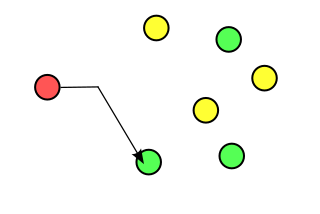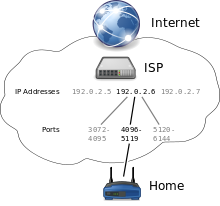The Internet Control Message Protocol (ICMP) is a supporting protocol in the Internet protocol suite. It is used by network devices, including routers, to send error messages and operational information indicating success or failure when communicating with another IP address, for example, an error is indicated when a requested service is not available or that a host or router could not be reached. ICMP differs from transport protocols such as TCP and UDP in that it is not typically used to exchange data between systems, nor is it regularly employed by end-user network applications.

Internet Protocol version 4 (IPv4) is the fourth version of the Internet Protocol (IP). It is one of the core protocols of standards-based internetworking methods in the Internet and other packet-switched networks. IPv4 was the first version deployed for production on SATNET in 1982 and on the ARPANET in January 1983. It is still used to route most Internet traffic today, even with the ongoing deployment of Internet Protocol version 6 (IPv6), its successor.

Internet Protocol version 6 (IPv6) is the most recent version of the Internet Protocol (IP), the communications protocol that provides an identification and location system for computers on networks and routes traffic across the Internet. IPv6 was developed by the Internet Engineering Task Force (IETF) to deal with the long-anticipated problem of IPv4 address exhaustion, and was intended to replace IPv4. In December 1998, IPv6 became a Draft Standard for the IETF, which subsequently ratified it as an Internet Standard on 14 July 2017.
The Internet Protocol (IP) is the network layer communications protocol in the Internet protocol suite for relaying datagrams across network boundaries. Its routing function enables internetworking, and essentially establishes the Internet.
The Internet protocol suite, commonly known as TCP/IP, is a framework for organizing the set of communication protocols used in the Internet and similar computer networks according to functional criteria. The foundational protocols in the suite are the Transmission Control Protocol (TCP), the User Datagram Protocol (UDP), and the Internet Protocol (IP). Early versions of this networking model were known as the Department of Defense (DoD) model because the research and development were funded by the United States Department of Defense through DARPA.
In computer networking, the User Datagram Protocol (UDP) is one of the core communication protocols of the Internet protocol suite used to send messages to other hosts on an Internet Protocol (IP) network. Within an IP network, UDP does not require prior communication to set up communication channels or data paths.

Network address translation (NAT) is a method of mapping an IP address space into another by modifying network address information in the IP header of packets while they are in transit across a traffic routing device. The technique was originally used to bypass the need to assign a new address to every host when a network was moved, or when the upstream Internet service provider was replaced, but could not route the network's address space. It has become a popular and essential tool in conserving global address space in the face of IPv4 address exhaustion. One Internet-routable IP address of a NAT gateway can be used for an entire private network.

In computer networking, the transport layer is a conceptual division of methods in the layered architecture of protocols in the network stack in the Internet protocol suite and the OSI model. The protocols of this layer provide end-to-end communication services for applications. It provides services such as connection-oriented communication, reliability, flow control, and multiplexing.

Anycast is a network addressing and routing methodology in which a single IP address is shared by devices in multiple locations. Routers direct packets addressed to this destination to the location nearest the sender, using their normal decision-making algorithms, typically the lowest number of BGP network hops. Anycast routing is widely used by content delivery networks such as web and name servers, to bring their content closer to end users.
In computer networking, Teredo is a transition technology that gives full IPv6 connectivity for IPv6-capable hosts that are on the IPv4 Internet but have no native connection to an IPv6 network. Unlike similar protocols such as 6to4, it can perform its function even from behind network address translation (NAT) devices such as home routers.
Best-effort delivery describes a network service in which a network does not provide any guarantee that data is effectively delivered or that delivery meets any quality of service. In a best-effort network, all users obtain best-effort service. Under best-effort, network performance characteristics such as transmission speed, network delay and packet loss depend on the current network traffic load, and the network hardware capacity. When network load increases, this can lead to packet loss, retransmission, packet delay variation, further network delay, or even timeout and session disconnect.
Anything In Anything (AYIYA) is a computer networking protocol for managing IP tunneling protocols in use between separated Internet Protocol networks. It is most often used to provide IPv6 transit over an IPv4 network link when network address translation masquerades a private network with a single IP address that may change frequently because of DHCP provisioning by Internet service providers.
A network socket is a software structure within a network node of a computer network that serves as an endpoint for sending and receiving data across the network. The structure and properties of a socket are defined by an application programming interface (API) for the networking architecture. Sockets are created only during the lifetime of a process of an application running in the node.
In computer networking, a port or port number is a number assigned to uniquely identify a connection endpoint and to direct data to a specific service. At the software level, within an operating system, a port is a logical construct that identifies a specific process or a type of network service. A port at the software level is identified for each transport protocol and address combination by the port number assigned to it. The most common transport protocols that use port numbers are the Transmission Control Protocol (TCP) and the User Datagram Protocol (UDP); those port numbers are 16-bit unsigned numbers.
The internet layer is a group of internetworking methods, protocols, and specifications in the Internet protocol suite that are used to transport network packets from the originating host across network boundaries; if necessary, to the destination host specified by an IP address. The internet layer derives its name from its function facilitating internetworking, which is the concept of connecting multiple networks with each other through gateways.
An IPv6 transition mechanism is a technology that facilitates the transitioning of the Internet from the Internet Protocol version 4 (IPv4) infrastructure in use since 1983 to the successor addressing and routing system of Internet Protocol Version 6 (IPv6). As IPv4 and IPv6 networks are not directly interoperable, transition technologies are designed to permit hosts on either network type to communicate with any other host.
NAT64 is an IPv6 transition mechanism that facilitates communication between IPv6 and IPv4 hosts by using a form of network address translation (NAT). The NAT64 gateway is a translator between IPv4 and IPv6 protocols, for which function it needs at least one IPv4 address and an IPv6 network segment comprising a 32-bit address space. The "well-known prefix" reserved for this service is 64:ff9b::/96.
IPv4 Residual Deployment (4rd) is an IPv6 transition mechanism for Internet service providers for deployment of Internet Protocol version 6 (IPv6), while maintaining IPv4 service to customers. The protocol and sample applications are specified in RFC 7600.
Mapping of Address and Port (MAP) is a proposal that combines A+P port address translation with the tunneling of legacy IPv4 protocol packets over an ISP's internal IPv6 network.
Port Control Protocol (PCP) is a computer networking protocol that allows hosts on IPv4 or IPv6 networks to control how the incoming IPv4 or IPv6 packets are translated and forwarded by an upstream router that performs network address translation (NAT) or packet filtering. By allowing hosts to create explicit port forwarding rules, handling of the network traffic can be easily configured to make hosts placed behind NATs or firewalls reachable from the rest of the Internet, which is a requirement for many applications.





